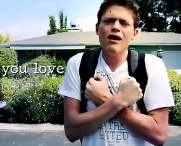Incorporating ASL Music Videos in an Accessible Multimodal Pedagogy
Reflecting on Accessible Multimodal Compositions
Some instructors might request that students analyze ASL music videos or other accessible multimodal compositions; others might ask students to design their own accessible multimodal compositions; others might work with students on assessing the inaccessibility of certain compositions. After students analyze, design, or assess accessible multimodal compositions, they should reflect on the process of engaging with these compositions. Through the reflection and writing process, students can explore and articulate how they relate to these compositions. Their reflections can show us the relative benefits of our approach and how we can redesign our strategies.
We can use students’ reflections to better assess what they have learned about making meaning accessible across multiple modes. Asking our students to be honest in their reflections about what they have learned or not learned—or about the inaccessibility of certain compositions—will help them and us work together towards making meaning clearer in different ways. Assessing their reflections allows us instructors to recognize the rhetorical skills for designing communication that students may have developed in the analysis and design process.
The strongest reflections indicate a recognition not only of how they made their videos accessible, but also the limitations of making compositions accessible. Students in my class have reflected on the length of time it takes to add visual text to short videos and the limitations in how much they can or cannot edit visual text in video editing software. They have had to work within the constraints of video editing software when changing the look or movement of visual text. Yet, recognizing the struggles gives them better appreciation for those who design accessible compositions.
To encourage meaningful reflection, I provide students with a range of questions that they are free to choose from to consider as they write their reflections on their analysis and design processes. I have provided a short list of possible questions to ask students after they assess accessible multimodal compositions.
Prompts for Reflecting on Accessible Multimodal Compositions
Analysis
- Would you recommend this music video to others? Why or why not?
- How do you feel about being able to access the meaning of this music video?
- What aspects of the video were most and least effective in allowing you to access this music video?
- If you could change the approach to this assignment, what would you change?
Design
- What were your individual and/or group goals for creating this video?
- Who was your audience and what was your purpose for this video? Do you feel you were successful in reaching out to this audience? Why or why not?
- What were the limitations, if any, of the video editing software that you used? What would you change if you had more time or more features in the software? How would you make the video more accessible?
- As you watch your video and your classmates’ videos, what reactions do you have as a viewer? Are they accessible? Could the videos become even more accessible and if so, how?
Depending on your approach, you could redesign these reflections in different ways. Regardless, I find individual written reflections to be the clearest indicator of what each student has learned about the process of making meaning accessible in different ways. I use these reflections to respond to each student and redesign the ways I teach accessibility and multimodality.
Redesigning Accessible Multimodal Compositions
We can build on the analysis and design of accessible multimodal compositions by asking our students to redesign these compositions. Introduce ASL music videos to your students, ask them to analyze the relative accessibility of these videos, let them design their own accessible compositions—then ask them to reflect on how these compositions are still not fully accessible. Ask them to reflect on how they, and we, can redesign these and other compositions to become more accessible to more people.
To consider how we can prompt students to redesign accessible multimodal compositions, I now ask composition instructors to reflect on the following questions:
Prompt for Redesigning Accessible Multimodal Communication
How might you redesign your accessible multimodal practices to reach out to your students in different ways? How could you communicate to different bodies and different senses? How could you show that meaning is more effective when conveyed across multiple modes?
Through analysis, design, reflection, and redesign, instructors and students alike can develop strategies and appreciation for accessing each other in multiple and different ways. The practices that I have provided are meant to be redesigned for different instructor and student bodies. We can redesign these practices and we can all use ASL music videos in different ways in various courses to support the principles of accessibility in multimodal compositions. And valuing differences is, to take us to the last example, the Deaf Professional Arts Network’s (2008) video, “D-PAN ASL music video: ‘Beautiful’ by Christina Aguilera.”
NEXT: Example #4: "Beautiful"
